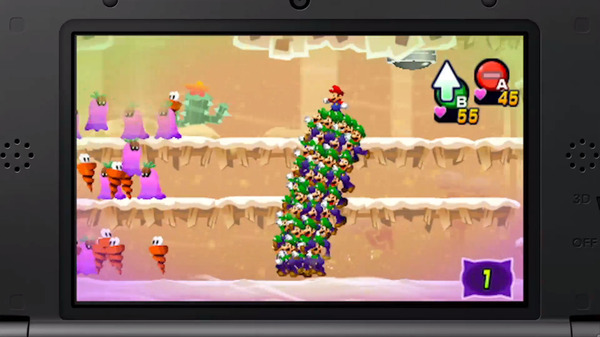
Like all Mario & Luigi games, Mario & Luigi: Dream Team is an RPG, insofar as you get experience points for killing monsters and you level up and fight enemies in exactly the same turn-based style Japanese RPGs have used since the early eighties. But there is no limit to how much the game does not care to resemble the genre in any other way. The world is in jeopardy and Mario and Luigi must save it, but the world is quirky and whimsical, adorably candy-colored and completely non-serious. There is turn-based combat, but it’s more like a rhythm game, or Simon, or even Super Mario Bros. than it is like Final Fantasy. There’s exploration, but it’s filled with puzzles and minigames and secrets.
There is some character customization and stat building, but even though it’s turn-based, all combat in Dream Team is determined by timing and reflexes. To do maximum damage, you hop on enemies right before the point of impact, or swing a hammer at the last possible second, and there are special moves that involve extensive 3D effects and use of the 3DS motion controls. Defense is equally complicated; enemies have a complex series of tells, and when those are learned a clever player will never take damage even once. Tells range in obscurity from whether the monster raises its foot toward Mario or Luigi before charging to how many times a spiky bee rolls its eyes before diving. The tells are often very silly. It helps that the game is so cute.
Often the saving grace of the RPG is its story, and though it’s rarely enough on its own, Mario & Luigi: Dream Team’s story is refreshing (again) simply for how cute and silly and unserious it is. The plot is that the ancient inhabitants of Pi’low island, the Pi’low folk (who look exactly like pillows, obviously), have all been trapped in stone pillows, and Luigi, lazier and more cowardly than Mario, must fall asleep on them so Mario can travel to the dream world and free them. This works so well because RPGs require less world-weary teens and more extremely strained puns.
Maybe what’s most unique and most engaging about the world of Dream Team is how thoroughly it’s stuffed with an almost overwhelming variety of things to do. The pacing of the game is meticulous and you are never talked at for very long before being offered something to break the tedium. Action doesn’t happen in cutscenes, and problems aren’t resolved just by talking to someone or pushing a button. There’s always a task, usually ridiculous, almost always fun, that moves the story forward. There’s a minigame about stopping a slot machine to make a water pump work, and a quiz show, and 2-D puzzle platforming. You’ll fling Mario around by tugging on Luigi’s mustache. Almost none of these actions or scenarios are repeated. The enemy design is just as varied—enemies appear just long enough to master beating, and after that, never show up again.
Dream Team avoids collapsing under this bewildering variety of tasks by presenting a few simple consistent actions—jumping, swinging a hammer—and then teaching dozens of ways to use them. The actions are consistent no matter the context, so it’s not a big leap to realize that when the game says you can break rocks with the hammer in the isometric overworld, you can break rolling boulders in the side-scrolling dream world the same way. Dream Team is well paced and though it does not get complicated quickly, it becomes quite challenging by the end. It is still extremely fair and friendly, though it may hold your hand longer than you like.
While the Mario and Luigi games have always been strong, and Dream Team is a wonderful entry, there is lost momentum in this latest iteration. The dream worlds are a nice change of pace but the mechanic there—Mario and Luigi combine to take on big groups of enemies—looks more exciting than it ends up being, which is not much different from the normal combat. In the previous game, Mario & Luigi: Bowser’s Inside Story, the switch between sidescrolling and isometric perspectives was combined with switching between Bowser and Mario. Bowser had a completely different set of actions and his arrogant, boisterous, clueless personality was a great foil to the silent Mario and Luigi (they communicate by jumping and emoting in Italian). And Mario & Luigi: Dream Team’s side characters desperately need some personality, between a generic main villain and the obnoxious Pi’low island leaders who are huge jerks and who get in your way for no reason other than so you’ll have something to do. The world is cute and fun, but there’s no one interesting to meet in it.
The pacing is beautiful in Mario & Luigi: Dream Team. It is meticulous. But as I find myself writing that sentence I can only feel like I’m praising the pacing because the game is missing the charm and character and outrageous fun that made the series stand out so much to me. Which is not to say that it’s charmless, but if Mario & Luigi: Dream Team was a Pixar film it’d be Cars not Toy Story.
Mario & Luigi: Dream Team was developed by AlphaDream and published by Nintendo. It is available for the 3DS.
Aevee Bee is freelance writer who maintains a surreal video game terror blog at http://mammonmachine.com/ and a twitter account, @mammonmachine, which is a popular resource for both anime puns and flirtation advice.
